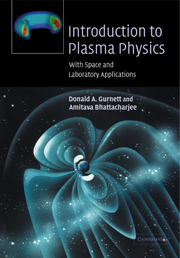Book contents
- Frontmatter
- Contents
- Preface
- 1 Introduction
- 2 Characteristic parameters of a plasma
- 3 Single particle motions
- 4 Waves in a cold plasma
- 5 Kinetic theory and the moment equations
- 6 Magnetohydrodynamics
- 7 Discontinuities and shock waves
- 8 Electrostatic waves in a hot unmagnetized plasma
- 9 Waves in a hot magnetized plasma
- 10 Non-linear effects
- 11 Collisional processes
- Appendix A Symbols
- Appendix B Vector differential operators
- Appendix C Vector calculus identities
- Index
- References
9 - Waves in a hot magnetized plasma
Published online by Cambridge University Press: 05 June 2012
- Frontmatter
- Contents
- Preface
- 1 Introduction
- 2 Characteristic parameters of a plasma
- 3 Single particle motions
- 4 Waves in a cold plasma
- 5 Kinetic theory and the moment equations
- 6 Magnetohydrodynamics
- 7 Discontinuities and shock waves
- 8 Electrostatic waves in a hot unmagnetized plasma
- 9 Waves in a hot magnetized plasma
- 10 Non-linear effects
- 11 Collisional processes
- Appendix A Symbols
- Appendix B Vector differential operators
- Appendix C Vector calculus identities
- Index
- References
Summary
In this chapter we discuss the propagation of small amplitude waves in a hot magnetized plasma. Just as for a cold plasma, the presence of a static zero-order magnetic field in a hot plasma leads to a wide variety of new phenomena. Because the zero-order motions of the particles in a magnetized plasma consist of circular orbits around the magnetic field, some type of resonance can be expected when the wave frequency is equal to the cyclotron frequency. In a cold plasma, this resonance is the same for all particles of a given charge-to-mass ratio, and gives rise to the well-defined cyclotron resonances described in Chapter 4. In a hot plasma, the frequency “felt” by a particle is Doppler shifted by the thermal motion of the particle along the static magnetic field. For a given parallel velocity, resonance occurs when the frequency in the guiding center frame of reference of the particle is at the cyclotron frequency, i.e., ω′ = ω − k∥ν∥ = ωc. Because of the thermal spread in the particle velocities, the resonance is no longer sharp, as it was in a cold plasma, but is now broadened by the thermal motion. The resonant interaction also produces damping, called cyclotron damping, in a manner somewhat analogous to Landau damping. If the cyclotron radius of the particle is a significant fraction of the wavelength, the phase shift introduced by the periodic cyclotron motion of the particles back and forth along the perpendicular component of the wave vector produces a phase modulation at the cyclotron frequency.
- Type
- Chapter
- Information
- Introduction to Plasma PhysicsWith Space and Laboratory Applications, pp. 341 - 390Publisher: Cambridge University PressPrint publication year: 2005
References
- 2
- Cited by



